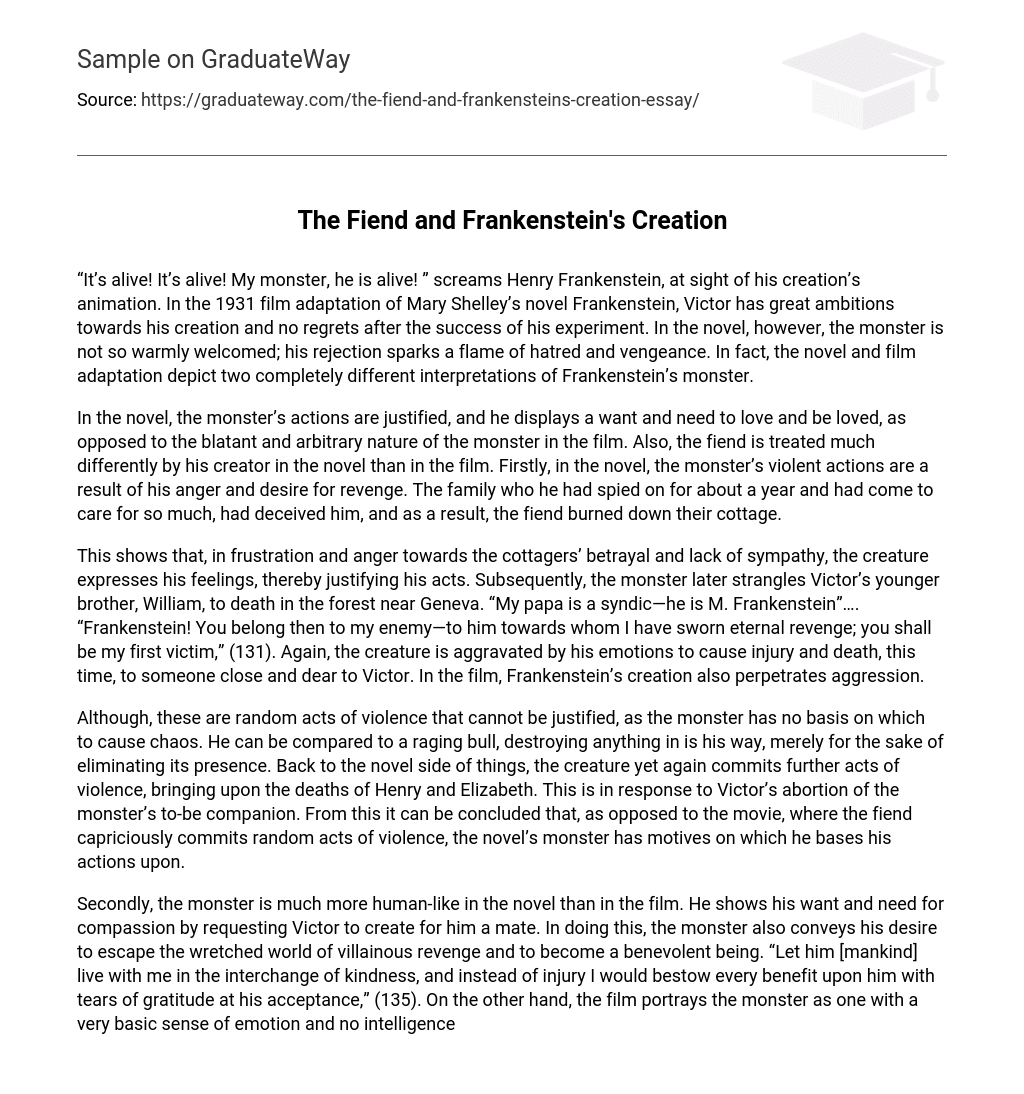“It’s alive! It’s alive! My monster, he is alive! ” screams Henry Frankenstein, at sight of his creation’s animation. In the 1931 film adaptation of Mary Shelley’s novel Frankenstein, Victor has great ambitions towards his creation and no regrets after the success of his experiment. In the novel, however, the monster is not so warmly welcomed; his rejection sparks a flame of hatred and vengeance. In fact, the novel and film adaptation depict two completely different interpretations of Frankenstein’s monster.
In the novel, the monster’s actions are justified, and he displays a want and need to love and be loved, as opposed to the blatant and arbitrary nature of the monster in the film. Also, the fiend is treated much differently by his creator in the novel than in the film. Firstly, in the novel, the monster’s violent actions are a result of his anger and desire for revenge. The family who he had spied on for about a year and had come to care for so much, had deceived him, and as a result, the fiend burned down their cottage.
This shows that, in frustration and anger towards the cottagers’ betrayal and lack of sympathy, the creature expresses his feelings, thereby justifying his acts. Subsequently, the monster later strangles Victor’s younger brother, William, to death in the forest near Geneva. “My papa is a syndic—he is M. Frankenstein”…. “Frankenstein! You belong then to my enemy—to him towards whom I have sworn eternal revenge; you shall be my first victim,” (131). Again, the creature is aggravated by his emotions to cause injury and death, this time, to someone close and dear to Victor. In the film, Frankenstein’s creation also perpetrates aggression.
Although, these are random acts of violence that cannot be justified, as the monster has no basis on which to cause chaos. He can be compared to a raging bull, destroying anything in is his way, merely for the sake of eliminating its presence. Back to the novel side of things, the creature yet again commits further acts of violence, bringing upon the deaths of Henry and Elizabeth. This is in response to Victor’s abortion of the monster’s to-be companion. From this it can be concluded that, as opposed to the movie, where the fiend capriciously commits random acts of violence, the novel’s monster has motives on which he bases his actions upon.
Secondly, the monster is much more human-like in the novel than in the film. He shows his want and need for compassion by requesting Victor to create for him a mate. In doing this, the monster also conveys his desire to escape the wretched world of villainous revenge and to become a benevolent being. “Let him [mankind] live with me in the interchange of kindness, and instead of injury I would bestow every benefit upon him with tears of gratitude at his acceptance,” (135). On the other hand, the film portrays the monster as one with a very basic sense of emotion and no intelligence at all.
This can be seen as the monster throws Maria into the water, to decipher whether or not she is buoyant, as the flowers are. Finally, in the novel, there are two instances at which the monster attempts to interact with society; first with the villagers, then the cottagers. This shows his need for one of the basic necessities of life; a sense of belonging in the world. The novel’s monster is much more human, and, along with his ebb and flow of emotions, we are able to relate our own lives with his.
Lastly, the manner in which the creature is treated by his creator is, without doubt, more outspoken in the novel. In the film, Victor is proud and quite optimistic; if not downright mad, at the completion of the monster’s biogenesis. This proves that Victor had the full intention of carrying out this experiment; a rather short-sighted act at that. On the contrary, when this is observed in the novel, Victor Frankenstein is immediately horrified at the sight of his creature when it comes to life. This means that creating the monster was something Victor immediately regretted.
Also, in the film, Victor struggles to control the monster and have it demonstrate obedience, rather than avoid all contact with it, as he did in the novel. A large aspect of the monster’s character and persona, and a foundation of hatred and vengeance are developed by Victor’s rejection, an element that was entirely omitted in the movie. The viewer/reader comes across two distinct characters under the same name when watching the 1931 film adaptation and reading the novel by Mary Shelley. The monster in the novel has justification for his actions, a sort of motive that drives him to commit violent crimes.
He also displays a requirement for the essential needs of human life, which include the capacity to love and belong. Lastly, the monster’s creator behaves differently towards his creation in the two mediums, producing differences in character and developmental nature. From the novel’s depiction of the monster’s different motives, actions, and emotions, the reader can develop a much deeper, more understandable connection with the monster. We are able to relate our lives with the monster, and feel his glee, as well as his gloom.





